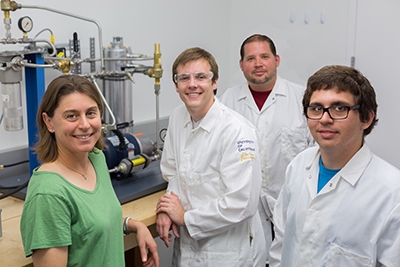The summer might mean an extended break for some in the campus community, but UC Merced researchers are busier than ever. Whether here or abroad, many professors and students are taking advantage of the time off to pursue important research projects.
Below are a few examples from the School of Natural Sciences and the School of Engineering. Researchers in the School of Social Sciences, Humanities and Arts are also keeping busy this summer.
• Applied math Professor Noemi Petra is spending 10 weeks of her summer in the Chicago area at Argonne National Laboratory.
As part of the U.S. Department of Energy’s Visiting Faculty Program, Petra is collaborating with computational mathematicians in the Mathematics and Computer Science Division at Argonne on developing efficient and scalable (inversion) methods for monitoring the United States’ power grid.
Petra’s goal is to apply her experience and expertise in inverse problems to the problem of dynamic parameter and state estimation, which will enable real-time power grid operational tasks such as monitoring, fault detection and dynamic stability assessment.
Another of Petra’s projects is understanding Arctic ice-sheet flows and how sea-rise will be affected by them.
“Both of these topics are so important for society,” Petra said. “I couldn’t be happier to work on them.”
 • Professor Ashlie Martini has two undergraduate students and one grad student working on a project with Chevron, looking at specific types of additives designed to minimize foaming in oils.
• Professor Ashlie Martini has two undergraduate students and one grad student working on a project with Chevron, looking at specific types of additives designed to minimize foaming in oils.
Foam commonly forms in lubricated systems because of gear meshing, turbulent flows and other gas introduction. Lingering foam, however, means lubricants are less able to reduce friction and wear, which adversely affects the efficiency of lubricated machine components. So Martini and her students have set up a series of test stations to see if they can reduce foam persistence.
Master’s candidate Sean Lantz, UC Merced undergraduate Cory Mercer and visiting Brazilian undergrad Julio Dos Santos are working on the project.
“This is a project where students at all levels can work directly with an industry partner to do research with significant potential for impact on energy efficiency of mechanical components,” Martini said.
• Professor Stephen Hart has three projects this summer, in addition to overseeing the Research Experience for Undergraduates (REU) program in Yosemite.
The REU is hosting nine students from all over the U.S. this year. Each student is paired with a researcher from UC Merced, the U.S. Forest Service and the National Park Service to work on projects together, giving students hands-on research experience they might not otherwise get.
This year’s projects include examining the effects of forests on snow accumulation, the effects of the Rim Fire on the grey owl population, and the effects of altitude on monkey flower mating systems and pollination. Hart and Professor Carolin Frank are mentoring two REU students to study biological nitrogen fixation in tree foliage and soil across the Yosemite High Country.
Hart is also working in the Southern Sierra Critical Zone Observatory (CZO) to study dust in the Sierra — how much there is, were it comes from and how it affects terrestrial ecosystems. He’s also collaborating with UC Merced Professor Josh Viers, Earthwatch, CalTrout and other organizations to evaluate the impact of montane meadow restoration on greenhouse gas emissions.
• Various Sierra Nevada Research Institute affiliates will also be at the CZO this summer, working different projects.
Students working with Hart and Professors Asmeret Asefaw Berhe and Marilyn Fogel are analyzing samples from excavation sites in the foothills, looking for nitrogen and phosphorus concentrations and stable isotopes to look at organic matter inputs.
Professor Martha Conklin and graduate student Melissa Thaw, in collaboration with Lawrence Livermore National Lab, are using isotopes to trace the age of water coming into mountain streams. Because of the lack of precipitation this year, much of the water in streams is likely coming from groundwater. The researchers will be able to see how young or recent the water inputs are in streams.
Graduate students in environmental science are also working on research projects this summer: the impact of disturbances such as timber harvesting and fire on soil fungi; modeling the relationship between river water levels and precipitation and the impact of plant water demands; the impacts of climate on nutrient cycling and ecosystem productivity; and updating the wireless sensor network for tracking water balances at the Southern Sierra CZO.
• Professor Andy LiWang and his students are continuing their work to elucidate the molecular mechanism of a biological clock to better understand the principles of biological timing.
Organisms have adapted to the relentless cycles of night and day by evolving an internal timekeeping system called the circadian clock, which induces healthy rhythms of rest and activity in synchrony with the Earth’s rotation. LiWang studies the circadian clock of cyanobacteria — the only system that can be reassembled from its individually purified components in a test tube, away from the complex milieu of live cells.
Once reassembled, the clock ticks for days and weeks on a lab bench, generating a macroscopic biochemical rhythm that can be studied at atomic resolution using nuclear magnetic resonance spectroscopy. Past studies have revealed that clock proteins interact to form complexes that dynamically rearrange throughout the day and night, and that these interactions have positive and negative feedback mechanisms essential to sustaining the clock’s oscillatory behavior.